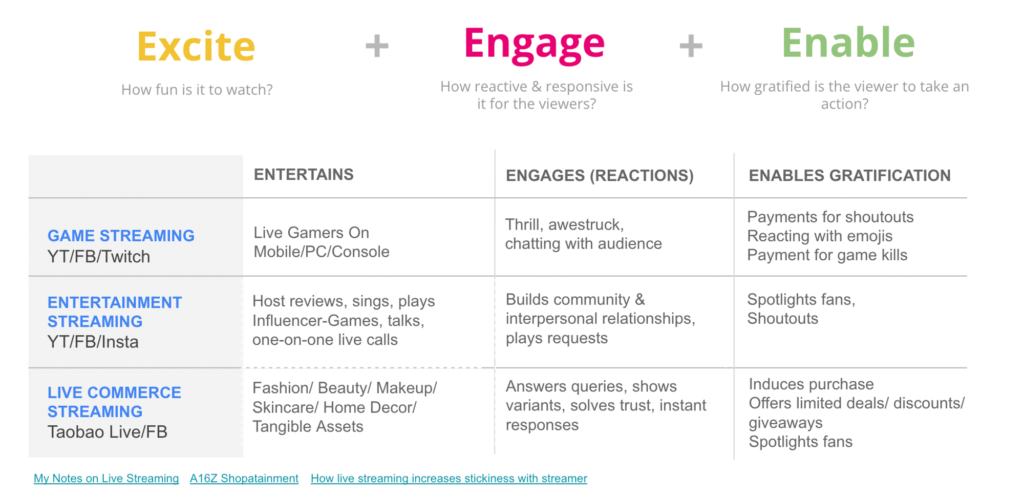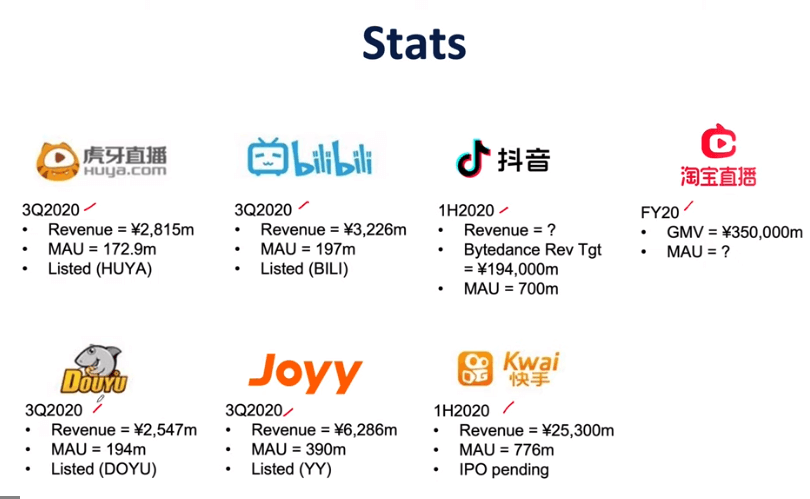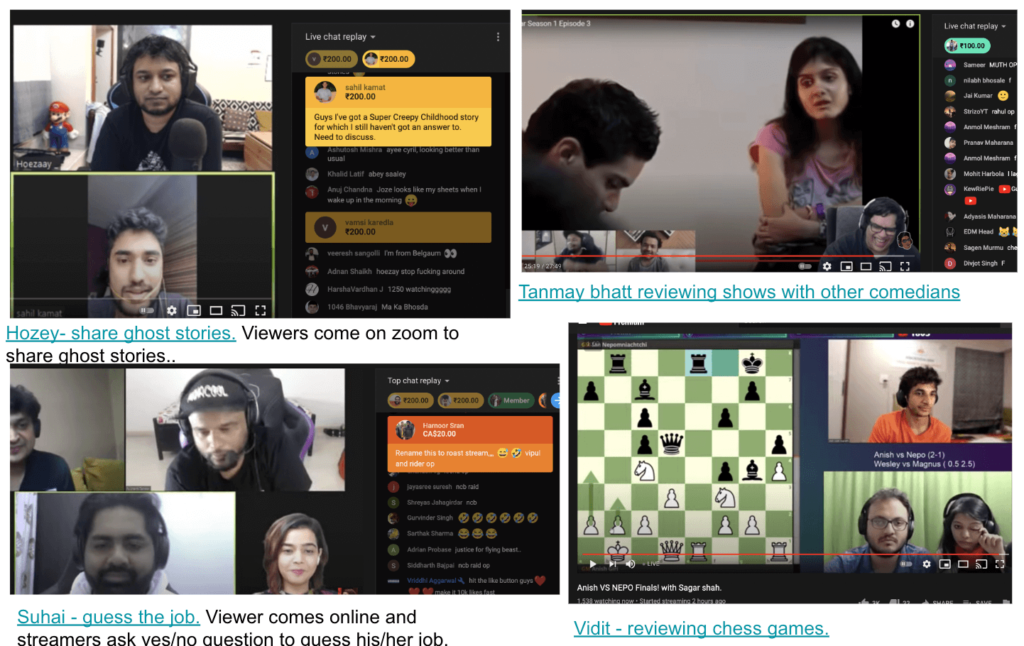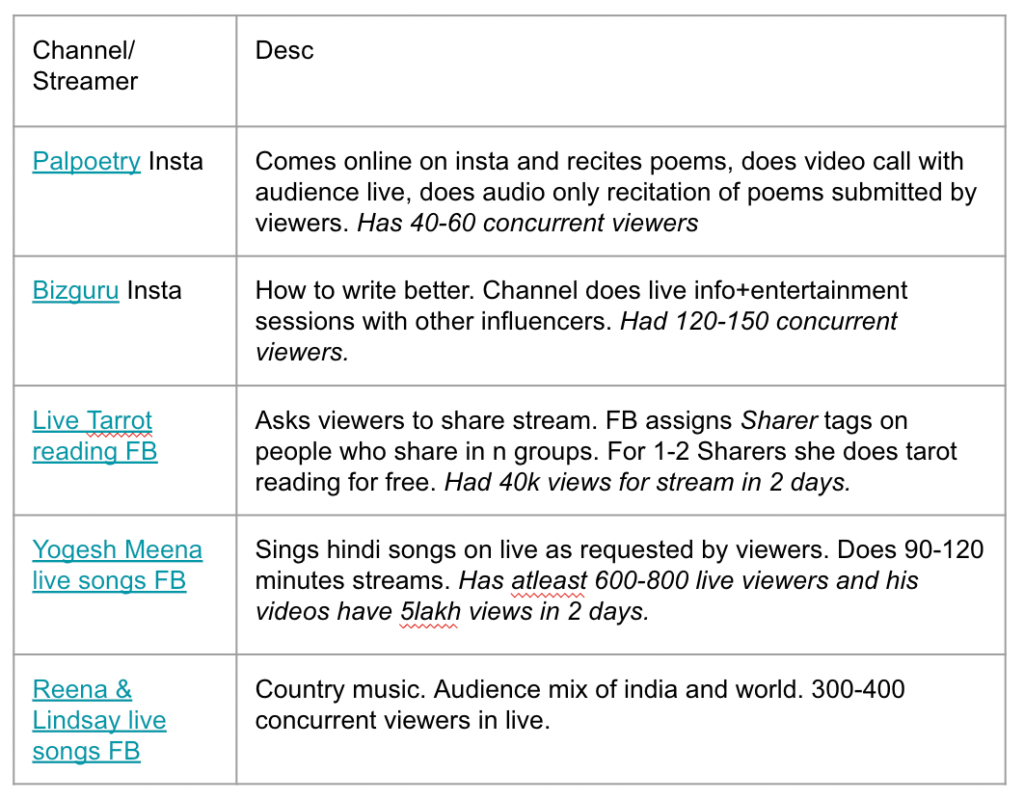Summary: Present below is my deep-dive on live entertainment or lifestyle streaming scene in India from early 2021. It covers what makes a successful stream, landscape in China, contrast with Indian platforms and monetization strategies.
This is the 2nd blog in my live streaming deep-dive. Check out the last piece covering game streaming.
Bottom Line: What makes any Live successful?

Live Entertainment Streaming 🎶

Basics
- Think radio but on web and video – Radio is also interactive and people still call on radio to participate. Same is with these livestreams.
- Consists of non-gaming streaming, featuring entertainment through comedy, just chatting, content review, music, fitness, and more. The format can be either audio or video.
- The focus now shifts from the game to the streamer, making engagement with people more challenging. A streamer's personality is crucial.
- The most successful lifestyle streamers engage their fans and make them feel like they are active participants in an intimate community, rather than detached viewers.
- To reduce the burden on the streamer’s personality, they engage the audience in other activities. This can include focusing on their talent (singing, dancing, etc.) or reviewing shows/movies, unboxing, and other activities.
- Cooking shows employ a similar phenomenon as described above. By blending the host’s personality with the dish being prepared, a sense of anticipation is created, ultimately resulting in a rush of dopamine.
Live Streaming Platforms in India

- YouTube and Facebook (not Instagram) are the most popular streaming platforms in India.
- Streamers usually stick to one platform and don’t do cross-platform live streams.
- Finding non-news live streams on YouTube can be difficult, while Facebook streams are random (in the Facebook live tab) and lack topical categorization.
- Both platforms have introduced gamification features to encourage viewer engagement.
- Mobile-first streaming apps like JL Stream, MX Takatak Live, and Bolo Indya are gaining popularity but often have poor (sleazy) content and focus on asking for money or followers.
- Chinese apps like Bigo, Popular Live, and Tango were popular before June 2020 but were filled with inappropriate content and not focused on entertainment.
Chinese Live Streaming Platforms – Crazy Scale!

- MAU livestreaming grew 31x from 5.6mn in 2012 to 176mn in 2017, with over 430mn viewers in 2019 (30% of China's population).
- Revenue increased from 16mn USD to 4bn USD in the same period (250x).
- Livestreaming relies on virtual goods, where viewers purchase digital items with real money to display on the stream.
- YY is the biggest company in live streaming, earning 90% of its revenue from virtual gifts. Last year, it had $1.6B in live streaming revenue and $400mm in operating income from over 16mm users.
- Viewers can purchase virtual gifts, digital items like roses, cars, yachts, and special effects to display on the stream using real money.
- Viewers pay for virtual social status rather than to reward the streamer.
- Post-2019, YY, Momo, TikTok, and Kuaishou dominate a 10bn+ USD market, with many other apps (1000+) shut down.
- Watch: youtube video to learn more about birth of live streaming in china
Monetisation & Mechanics
- Donations/virtual gifts are the most profitable, followed by subscriptions and ads.
- However, Indian startups pay streamers based on a combination of likes and hours streamed. This has resulted in streamers without specific talent or skill coming online, where beauty and looks are a major selling point.
- In China, the process involves three steps: Streamer → MCN (Talent agency) → Streaming platform (YouTube).
- The same model is being followed in India with MX Takatak + JL Stream + BoloIndya. Leher also has a streaming platform and a mature audience (but very less chance an audio platform will suceed).
- However, in China, streamers use state-of-the-art equipment and not just mobile devices.
- Revenue is shared among the platform (50%), MCN (30%), and streamer (20%). Brutual working hours for streamers who do this professionally.
But why is entertainment live streaming popular?
- Streaming for 3-4 hours creates a natural and authentic setting, allowing viewers to connect with the streamer as a person rather than just the activity they are doing (as often happens in games). Once viewers feel connected, they are more likely to return.
- The longer the stream, the greater the engagement and views.
- Interesting note on such parasocial relationships here which explores same themes as above.
Streaming on Youtube

- Most streams are done from desktop using tools like zoom, OBS and multiple monitors.
- Entertain the audience through storytelling or easy-to-tell content, such as reviewing other shows, rather than relying on your personality.
- Further, engage with viewers through interactive streams, such as playing quizzes and giving prizes to winners.
- It is difficult to find these streams on YouTube.
- The typical age range of viewers is 18-30, and tips are generally lower than those for gamers, except for Tanmay.
Streaming on Facebook

- Popular on Facebook, not on Instagram. Viewer and streamer age varies from 25-40. FB has wider & older distribution than YouTube.
- Streams on Facebook are more diverse (content types) as compared to YouTube.
- Mobile is the default choice for streamers on FB.
- FB has invested heavily in their product, with viewers tagged as TopFan, Sharer, Gives Stars, Memberships and Winning Streak. Insta has a question feature but no tips.
- Chats on FB are mature with no vulgar comments, unlike some Indian apps.
- Finding streams is not easy on FB, but the platform notifies users when people they follow go live.
Questions To Ponder
- Seems to me the weakest form of streaming (and thus the most difficult to win). What are the streamer earnings in this?
- In China rural and tier 3-4 is big on live streaming as other sources of entertainment are missing. Is this true in India? Also, will these viewers be able to chat?
- Is majority of Entertainment Live streaming in China still just sleaze? Same would happen in India then.
- Optimist scenario – religious live streaming potentially can be big (if not already). Gamification and rich features can lead to high engagement.
